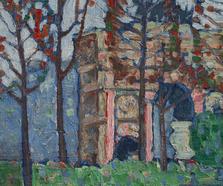“Art is not subject to political games; its importance elevates it above any racial difference. All men of talent, of noble spirit, can make it.”[i]
“It struck me that if I paint a person—no matter how I do it—it is a lie. The truth is in the physical brushstroke and the subject of the painting is the paint itself.”[ii]
Born in the Storyville section of New Orleans and raised in Chicago, Ed Clark (1926-2019) demonstrated a talent for art from a very young age. During the Second World War, he served in Guam in the US Army Air Corps. Afterwards, funding from the GI Bill enabled him to study at the School of the Art Institute of Chicago (1947-1951) before going to Paris in 1952 to study at the Académie de la Grande Chaumière. Removed somewhat from the racism that was a daily part of US life for black Americans, Clark flourished in Paris. Shortly after his arrival, he attended the Salon d’Autumne and saw Nicholas de Staël’s The Footballer, an energetic quasi-abstract representation that relied on planes of color to create the subject of its title. The painting had a profound effect on his art, and Clark became even more convinced in his pursuit of abstraction. Clark’s time in Paris enabled him to develop as an artist and to move permanently away from figural representation. In this aspect, his experience was similar to that of his close friend Beauford Delaney, another African American expatriate in the city. In 1955, Clark had a solo exhibition at the Galerie Raymond Creuze, and that same year, he received the Prix d'Othon Friesz from the Musée des Arts Decoratifs of the Musée du Louvre, Paris.
Despite the success Clark experienced in France, he was interested in the dynamism of the New York scene as described to him by friend and sculptor George Sugarman. In 1957, Clark returned to the United States and settled in New York, where a second wave of abstract expressionism was on the rise. That same year, he became a founding member of Brata Gallery, an artists collective that included Sugarman, as well as Al Held, Sal Romano, John Krushenick, and Ronald Bladen. That same year, Brata exhibited the first shaped canvas painted in the United States; it was a work by Clark. According to Clark, the idea of a shaped painting came to him more out of practical than artistic concerns. To save money, he had begun painting on paper, but he also had a canvas he was working on, “I liked what I was doing with the two, but they were separate from each other. I tried to put some torn paper over the canvas, but nothing worked until it went outside the edges, so I built up behind the limp paper with wood. And that’s how it started. Everybody saw it because everyone was there on Tenth Street. . . . And it struck everybody. They’d never seen a painting like that. And they wrote about it right away. I was the first, and it’s documented.”[iii]
Clark’s brushstrokes had been getting “bolder and looser, conceived by the artist as bearers of ‘energy and speed.’”[iv] By 1963, he had devised an entirely new method of applying paint to canvas. Laying his canvas on the studio floor, Clark began using push brooms to apply paint. Sometimes he would use the brooms freely, and sometimes they would be guided by wooden tracks he built, a practice that enabled him to have faster, more far-reaching lines while maintaining control of the broom. The new technique resulted in bold, energetic waves of color that retained a palpable sense of the artist’s intervention on the canvas. In 1966, Clark returned to Paris and ultimately set up a residence there, dividing his time between the two cities he now called home. Since then, he has exhibited consistently in the United States and Europe. In 1971, Clark traveled to Crete, where his friend the painter Jack Whitten was staying. In Crete, Clark was unable to find the acrylic paint he preferred to work in. Using only the pastels he had brought with him, Clark created a series of twelve works. When he returned to the United States, he realized that his entire color scheme in those pastels had been influenced by Crete. Once he realized how important setting was to his approach to color, Clark started traveling as often as he could, making work in Brazil, Nigeria, Mexico, Martinique, and Morocco.[v]
During his lifetime, Clark was the recipient of numerous honors and awards, including two Master Awards for Painting from the National Endowment for the Arts (1972 and 1985), a CAPS Grant from the New York State Council on the Arts (1975), a Congressional Achievement Award (1994), a Joan Mitchell Award (1998), and most recently, a Legends and Legacy Award from the Art Institute of Chicago in 2013. His 1968 painting The Big Egg was acquired for the National Museum of African American History and Culture, Smithsonian Institution, in Washington, DC, and his work appears in numerous public collections throughout the world including the Art Institute of Chicago; The Studio Museum in Harlem (New York, NY); Detroit Institute of Arts; California African American Museum, Los Angeles; Museum Solidarity, Titograd, Yugoslavia; Museu de Arte Moderna de Bahia, Salvador, Brazil; and Centro de Arte Moderno de Guadalajara, Mexico.
[i] Edward Clark, “Un musée pour Harlem” Paris L'Art Vivant, November 1968. Quoted in “Ed Clark,” Peg Alston Fine Arts, http://pegalstonfinearts.com/Ed-Clark (Accessed February 2014).
[ii] “Ed Clark,” Art Institute of Chicago. http://www.artic.edu/exhibition/ed-clark (Accessed February 2014).
[iii] Clark, in Jeff Edwards, “The Long Sweep. A Conversation with Ed Clark about His 60-Plus Years in the Art World,” ArtPulse. http://artpulsemagazine.com/the-long-sweep-a-conversation-with-ed-clark-about-his-60-plus-years-in-the-art-world (Accessed February 2014).
[iv] “Ed Clark,” Art Institute of Chicago.
[v] Edwards, “The Long Sweep.”


